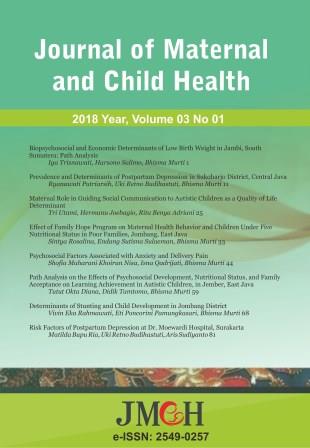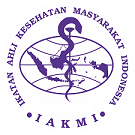Risk Factors of Postpartum Depression at Dr. Moewardi Hospital, Surakarta
Abstract
Background: Postpartum depression is one of the emotional disturbances that results from failure to postpartum psychological adaptation process. The global prevalence of postpartum depression is 10-15%. This study aimed to analyze the risk factors of pregnancy on the incidence of postpartum depression.
Subjects and Method: This was an analytic and observational study with a cross-sectional design. The study was conducted at Dr. Moewardi hospital, from December 2017 to January 2018. A total sample of 150 postpartum mothers was selected for this study by exhaustive sampling. The dependent variable was postpartum depression (PPD). The independent variables were maternal age, stress, parity, unwanted pregnancy, type of labor, family income, family support, and domestic violence. The data were collected by questionnaire and analyzed by path analysis model.
Results: Postpartum depression was directly and positively affected by psychological stress (b= 2.15; 95% CI= 1.17 to 3.13; p<0.001), delivery type (b= 1.27; 95% CI= 0.32 to 2.21; p= 0.008), and unwanted pregnancy (b= 1.57; 95% CI= 0.57 to 2.58; p= 0.002). Postpartum depression was directly but negatively affected by family income (b= -1.52; 95% CI= -2.51 to -0.54; p= 0.002), parity (b= -1.24; 95% CI= -2.21 to -0.28; p= 0.011), and family support (b= -1.31; 95% CI= -3.28 to -0.24; p= 0.016). Psychological stress increased with domestic violence (b= 2.68; 95% CI= 0.64 to 4.73; p= 0.010) and decreased with maternal age (b= -0.91; 95% CI= -1.68 to -0.13; p= 0.022). Parity increased with maternal age (b= 1.66; 95% CI= 0.79 to 2.53; p<0.001). Domestic violence decreased with maternal age (b= -1.34; 95% CI= -2.85 to 0.16; p= 0.081).
Conslusion: Psychological stress, delivery type, unwanted pregnancy, family income, parity, and family support, are direct risk factors for postpartum depression.
Keywords: Postpartum depression, unwanted pregnancy, domestic violence, family support
Correspondence:
References
Alligood MR (2013). Nursing Theory Utilization and Application, Journal of Chemical Information and Modeling. doi: 10.1017/CBO9781107415324.004.
Ariyanti R, Nurdiati DS, Astuti DA (2016). Pengaruh Jenis Persalinan Terhadap Risiko Depresi Postpatum, Jurnal Kesehatan
Dewi VNL, Sunarsih T (2011) Asuhan Kehamilan untuk Kebidanan. Jakarta: Salemba Medika.
Dira IKPA, Wahyuni AAS (2016). Prevalensi dan Faktor Risiko Depresi Postpartum di Kota Denpasar Menggunakan Edinburgh Postnatal Depression Scale
Fairus M, et al. (2014). Hubungan Dukungan Suami Dengan Kejadian Depresi Postpartum Pada Ibu Nifas, Jurnal Kesehatan Metro Sai Wawai, 7(1): 11
Herlina YN (2014). Hubungan Stresor Psikososial pada Kehamilan dengan Partus Prematurus, Jurnal Kesehatan Andalans, 5(1): 129
Ibrahim F et al. (2012). Faktor-Faktor yang Berhubungan Dengan Depresi Postpartum di RSIA Pertiwi Makassar Tahun 2012, (82).
Janiwarty B, Pieter HZ (2013) Pendidikan Psikologi untuk Bidan Suatu Teori dan Terapannya. Yogyakarta: Andy Offset.
Kenwa P, Karkarta MK, Triyani IGA (2015). Pengaruh Pemberian Konseling Terhadap Depresi Post Partum di Puskesmas II dan IV Denpasar Selatan, COPING Ners Journal, 3(2).
Kusuma PD (2017). Karakteristik Penyebab Terjadinya Depresi Postpartum pada Primipara dan Multipara, Jurnal Keperawatan Notokusumo, 5(1): 36
Marmi (2014) Asuhan Kebidanan pada masa Antenatal. Yogyakarta: Celeban Timur UH.
Mashudi F (2013). Psikologi Konseling: Buku Panduan Lengkap dan Praktis Menerapkan Psikologi Konseling. Yogyakarta: IRCiSoD
Patel M, Bailey RK, Jabeen S, Ali S, Barker NC, Osiezagha K (2012). Postpartum Depression: A Review, Journal of Health Care for the Poor and Underserved, 23: 534
Mathisen SE, et al. (2013). Prevalence and Risk Factors for Postpartum Depressive Symptoms in Argentina: A Cross Sectional Study, International Journal of Women
Motzfeldt I, et al. (2013). Prevalence of Postpartum Depression in Nuuk, Greenland
Oktarina MM (2016). Faktor-Faktor yang Berhubungan dengan Potpartum Blues di Rumah Sakit Muhammadiyah Palembang, Jurnal MUSWIL IPEMI Jateng, 114
Reid KM, Taylor MG (2015). Social Support, Stress, and Maternal Postpartum Depression: A Comparison of Supportive Relationships, Social Science Research. Elsevier Inc., 54: 246
Rusli RA, Meiyuntariningsih T, Warni WE (2011). Perbedaan Depresi Pasca Melahirkan pada Ibu Primipara Ditinjau dari Usia Ibu Hamil, Jurnal INSAN, 13(1): 21
Suparyanto (2014) Konsep Pendapatan Keluarga. [Online] Tersedia: http//drsupryanto.blogspot.com/2014/03/ Dasarkonsep dasarpendapatankeluarga.httml. Diakses 21 Agustus 2017.
Taherifard P, et al. (2013). Socioeconomic, Psychiatric and Materiality Determinants and Risk of Postpartum Depression in Border City of Ilam, Western Iran, Journal of Hindawi Publishing Corporation. doi: 10.1155/2013/653471.
Indriasari S (2017). Tingkat Depresi Pada Ibu Postpartum di Puskesmas Morokrembangan Surabaya, Jurnal Dunia Keprawatan, 5: 43











